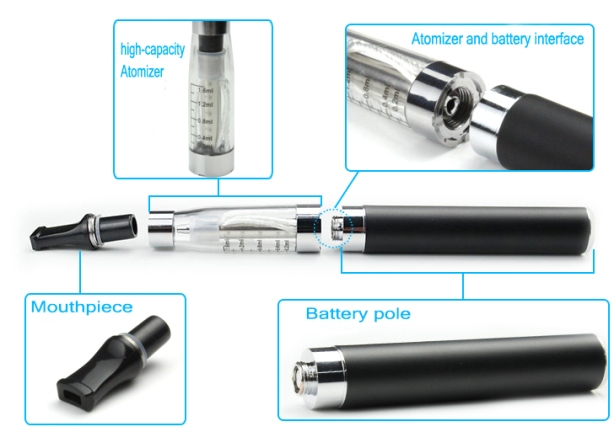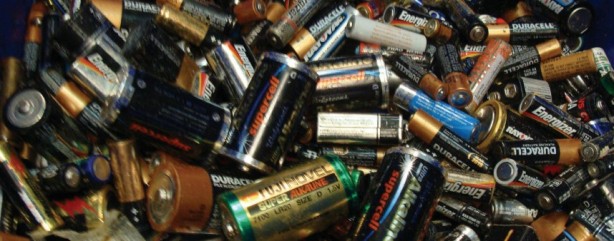A researcher by the name of Hoshing Chang scoured library archives, online repositories of scientific journals, and authoritative websites and other resources for a comprehensive review of available literature on the impact of e-cigarette manufacturing and consumption to the environment. Here's a summary of the information she found.
 |
| Basic Components of an Electronic Cigarette |
Component Manufacturing and E-cigarette Assembly
Although the bulk of electronic cigarettes are manufactured in China and in other countries, several small factories that handle the production and assembly of the e-cigarettes are located in North America. Unfortunately, collection of individual and cumulative e-cigarette pollutant emission information from all manufacturing sites isn't possible at this time. Many of these small-time manufacturers aren't required by the U.S. Environmental Protection Agency (EPA) to submit emission information each year because they didn't meet the Toxics Release Inventory (TRI) Program criteria.
Nicotine Extraction, Synthesis and Purification
Some e-juice manufacturers boast that they only use USP-grade nicotine in all their products. Other companies that weren't as vocal with the quality of their ingredients are probably using nicotine that's either derived from a natural source, such as tobacco leaves, or chemically synthesized using organic solvents, such as formaldehyde and dichloromethane.
 |
| Nicotine Logo by Seb Dominguez |
Companies involved in extracting and producing liquid nicotine are likely to have the highest emissions and waste products. Without proper regulation and control, the total emissions from these manufacturing companies would be substantial in an industrial scale setting.
The Wall Street Journal Market Watch reported in 2013 that Virginia Tobacco Company, a subsidiary of Universal Corporation, a leading global leaf tobacco supplier, has joined Avoca, one of the world's premier botanical extraction companies, to form AmeriNic, which will produce liquid nicotine for the e-cigarette industry.
Indoor Air Quality and Secondhand Aerosol Exposure
Several research studies were done on the chemical components and side effects of secondhand aerosol that remained in the air after volunteers used their electronic cigarettes in different indoor areas, including a small testing chamber. The researchers found that particulate matter as well as traces of nicotine and flavoring components were detected in each testing area.
It's obvious that the indoor air quality had changed significantly after the volunteers filled those areas with clouds of vapor using different types of e-cigarettes and vaping different brands of e-liquids. Unlike secondhand and third-hand smoke from cigarettes, the chemicals found in the vapors didn't stick to surfaces or become absorbed into fabric, or even remained in the air for long. The chemicals that were detected came from the exhaled breaths of the vapers, captured aerosol samples, and trapped air in places that didn't have a ventilation system.
 |
| Make sure you follow the proper procedure in disposing your e-cig batteries, empty cartridges, and discarded atomizers. |
Proper Disposal of Disposable E-cigs, Empty E-liquid Cartridges, and Depleted Batteries
A comprehensive review of the available literature on the environmental impact of electronic cigarettes revealed that there aren't any guidelines in place that would instruct companies on how to properly dispose of the empty cartridges, depleted batteries, broken atomizers, and disposable e-cigarettes, as well as the expired and unused products from their warehouses.
When a pharmaceutical product with nicotine as the sole active ingredient (e.g., nicotine patches, gum and lozenges) is discarded without being used for its intended purpose, it is classified as a Resource Conservation and Recovery Act (RCRA) hazardous substance.
However, a discarded used product is not included under RCRA. E-cigarettes are not a pharmaceutical product; therefore, the disposal of e-cigarettes is not regulated under RCRA or any other programme. This means that the unused and the used cartridges containing residual nicotine can be disposed of without treatment to remove nicotine.
Although many manufacturers have initiated recycling programmes for their e-cigarette cartridges and batteries, the prevalence and frequency of recycling for these used products are largely unknown.
Because there's no standard procedure for the proper disposal of disposable cig-a-likes, these types of e-cigs and their batteries and components were often sent to landfills as they were found. As a result, heavy metals from disposable e-cigs and nicotine residue from crushed batteries would seep into the earth. Most of the metals and chemical would pass through the underground striata of sediment, sand, soil and rock until those toxic substances reached the water bed and contaminated the water supply.
The Promise of Sustainability and "Green" Vapor Products
I guess, a shift towards a more sustainable approach to manufacturing and the adoption of eco-friendly packaging for vaporizers and e-juice products would be too much to hope for at this point. Vaping businesses might not survive for long if the FDA were to gain the power and authority to regulate and heavily tax the industry before the FDA Deeming Authority Clarification Act of 2015 (HR 2058) was finally approved.
Blaming one-time users who bought disposable cig-a-likes and e-cigarettes that made use of replaceable, but non-refillable cartridges won't change things. Do you know what would make a difference? Everyone should promote drip and tank rebuilding, coiling and dripping as environment-friendly vaping practices.
A true-blooded vaper understands the value of investing in rebuildable drips, tanks and atomizers, and in the essential gadgets and tools for rebuilding. The time and effort they spent in refilling their clearos with e-liquid, in building their coils, and in concocting their own e-juice recipes also contribute to the cause. Vapers are also famous for recycling their rebuilding materials, reusing e-cig parts, and upcycling their old box mods by accessorizing with vinyl stickers and repainting the bodies or skins of their vaporizers. All of these methods were effective in reducing a goodly chunk of their carbon footprint.
It would be much more sensible to try and replace the smoking habit with using the Best dripping atomizer. One can Buy eleaf ikonn total Online for discounted rates if they do a proper search for the best deals.
ReplyDeleteWhether your priority is taste or variety, VaporFi is will fill your vaping needs.
ReplyDeleteWith vape juices which come from food-grade ingredients, their vaping flavors are very smooth and consistent.